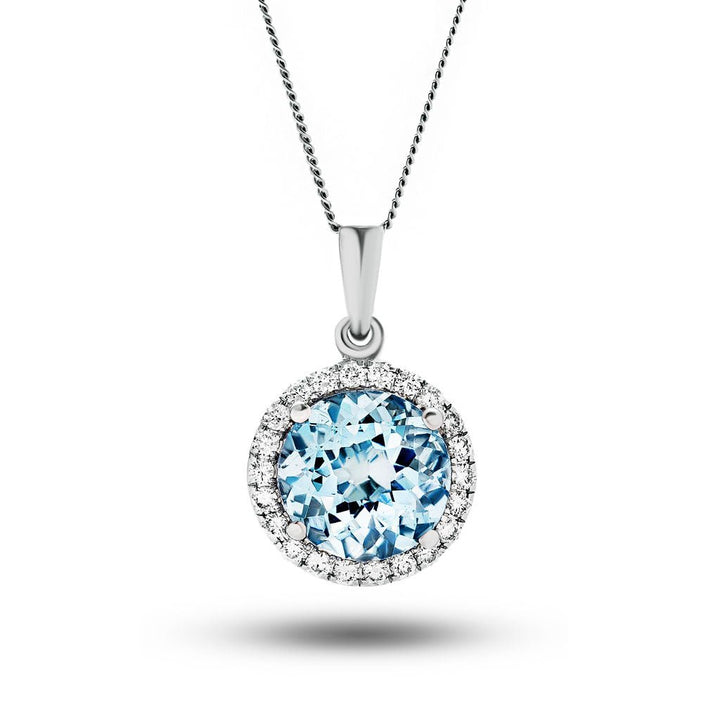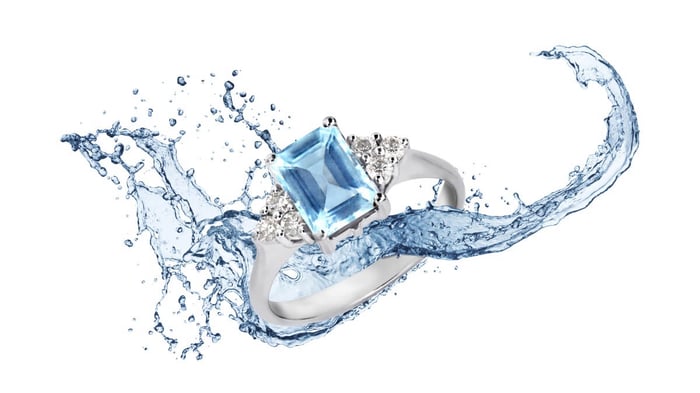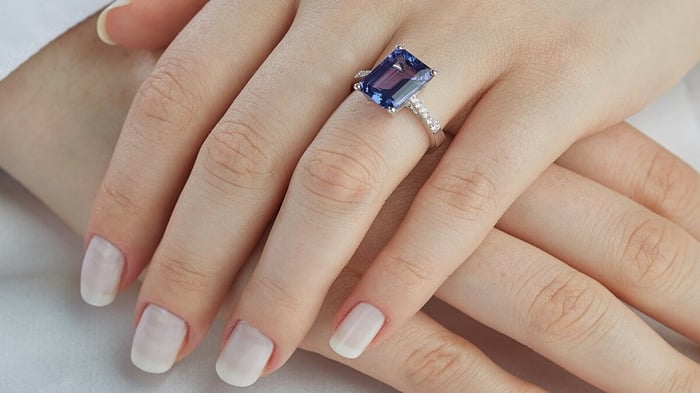About Aquamarine - It's Emotional Power And Why Aquamarine Is A Great Choice For Jewellery
This article gives a brief history of aquamarine, outlines its physical properties and how to choose the right gem for your jewellery. If you want to find out about aquamarine, you're in the right place!
Are you going through a difficult time right now? Is the stress level in your life affecting you physically, emotionally, and spiritually? Do you feel like you're losing control of your life and not able to get yourself out of a funk? If you answered yes to any of these questions, you might want to consider using the calming power of Aquamarine to help you through whatever it is that's causing you to feel down.
Aquamarine has been used since ancient times to calm the mind and balance emotions. It is also used in many different cultures as a healing stone. It is believed that the water in aquamarine is purer than that of any other gemstone, making it an excellent stone for anyone wanting to purify their energy. It is also believed that the colour of the stone changes depending on how much stress the person is under. When the stress level is high, the stone turns a darker blue; when the stress is lower, the stone becomes a lighter green.
Aquamarine is a very peaceful stone that helps to bring you back to the present moment. It is said to promote relaxation, reduce stress, and help you to let go of worries and worries about the future. This stone brings balance to mind and emotions, so you may find yourself having fewer arguments with friends and family and being more peaceful and calm.
If you want to clear out a stressful situation or change your perspective on a problem, aquamarine is a powerful stone to help you achieve that goal. It can also help to bring you closer to your spiritual self. It can help you get out of a rut and help you to get back in touch with the inner wisdom and guidance within you.
Because of its ability to clear the mind, aquamarine is often used in combination with other stones to help you gain a new perspective on a problem and come up with a solution. In this case, aquamarine helps to bring you back to the present moment, and the other stone helps you to look at the problem from a new angle.
Aquamarine-Related Meanings And Beliefs
Over the centuries many beliefs have built up about aquamarine. Aquamarine has long been prized by oracles and fate tellers. Aquamarine was the preferred material for manufacturing crystal balls.
Aquamarine is said to bring triumph in legal conflicts and disagreements. For more physical problems, aquamarine was thought to alleviate burping and yawning and toothache. Pliny the Elder stated in his Natural History that most eye illnesses might be treated by washing a patient's eye with water with an aquamarine submerged in it.
Aquamarine, according to devotees, can control the weather, keeping the rain away from outdoor events.
Aquamarine is still used by some alternative healers today. Some argue that it should be used to help people who are afraid of public speaking. It enables speakers to express themselves clearly and without resentment. Aquamarine is a love crystal that encourages a faraway lover to return, facilitates the coexistence of diverse personalities, and minimises the sensitivities that lead to quarrels.
Aquamarine, The March Birthstone Associated With Blue Seas And Skies
Aquamarine is a gorgeous blue gemstone with the colour of our imagination's fantasy ocean oceans. Aquamarine has represented hope, health, youth, and faithfulness for decades. Because the stone is the colour of both the sea and the sky, it signifies everlasting life to many people.
Colours can range from pastel to greenish-blue to dark blue. The darker blue colours are becoming increasingly rare.
If you want a dark colour, keep your eyes open for larger stones. Smaller stones will seem lighter.
The Long History Of Aquamarine
Aquamarine has been used from the time of the Ancient Egyptians and Sumerians. Both cultures believed that aquamarine might grant its possessor endless youth and contentment. During the Pharaonic period, it was typical for Egyptians to be buried with aquamarine artefacts to be utilised in the owner's future life.
Some 3000 years ago, Greek artists used aquamarine in their creations – including their sculptures. As an aside, although Greek statues are today white or light grey, the colour of the stone used by their sculptors, at the time, it was usual for statues to be painted. Over the centuries, the paint was worn away, and today we do not imagine these magnificent creations as ever having been painted in bright colours.
In Roman times, fishermen referred to the stone as "aqua marina" or "seawater" and believed it might bring them abundant catches. The stone was considered to keep Roman sailors safe on lengthy travels. More broadly, Romans thought the stone had cleansing properties, and they carved drinking containers out of enormous crystals. To promote harmony and friendliness to ceremonies when the aquamarine chalice was used, a frog was frequently engraved into such chalices.
Collar de aguamarina con diamantes G/SI de 1,75 ct y 0,18 ct en oro blanco de 18 k

€1.175,95
Atractivo y elegante, este collar con colgante de aguamarina y diamantes deslumbrará con gracia en el escote de su ser querido. Este colgante y collar están elaborados en lustroso oro blanco de 18 quilates. El colgante presenta una aguamarina vibrante… read more
By the Middle Ages, aquamarine's popularity had travelled to England, where it is cited in the 1377 poem Piers Plowman as a cure for poisoning. This notion persisted across Europe for several decades. Poisoning was a common destiny for the powerful and rich during the period, increasing the aquamarine’s demand.
In 1910, the biggest high-quality aquamarine crystal ever discovered was discovered in Brazil. The stone weighed more than 90 kg. After cutting, it yielded jewels weighing more than 200,000 carats. The Dom Pedro Aquamarine, mined in Minas Gerais, Brazil, in about 1980, is the largest single cut and faceted aquamarine gem. The gem is 36cm by 10cm and weighs 10.33 carats. It is currently on exhibit at the Smithsonian Institution in Washington, D.C.
Aquamarine Belongs To A Larger Family Of Gemstones
Aquamarine belongs to the beryl family of stones, including emeralds, golden beryl, goshenite, morganite, and red beryl. The colour of these crystals is caused by impurities in the stone. Beryl may be entirely translucent and was used to build eyeglasses in the 13th century.
Beryl, the crystal that forms the basis of aquamarine, is composed of beryllium aluminium cyclosilicate that has crystallised due to heat and pressure. Some crystals can be enormous.
Aquamarine gets its blue colour from tiny quantities of iron. By hitting green, pink, or yellow beryl with radiation, dark aquamarine stones known as maxixe can be created in laboratories and turned into jewellery.
Aquamarine may be found almost everywhere beryl can be found. Large quantities of aquamarine crystals may be found in Sri Lanka, Brazil (notable for green-yellow hues), Madagascar, numerous states in the United States, and major amounts in Colombia, Zambia, Malawi, Kenya, and Tanzania.
The most fabulous aquamarine stones come from Brazil, where the colours are a highly valued deep blue.
Aquamarine Jewellery Selection And Application
Almost all aquamarines used in jewellery have been heated to around 430 degrees. Heat treatment darkens the colour of the gemstone and reduces any yellow-green tones.
Aquamarine may be cut into a variety of shapes and sizes, but the most common are emerald cuts, followed by oval and pear forms. It has a Mohs hardness of 7.5-8, making it suited for most types of jewellery and most situations. If used as a ring stone, it is worthwhile to have the gem polished every few years to restore the brilliance to its former state.
Aretes ovalados de aguamarina y racimo de diamantes de 2,50 quilates en oro blanco de 18 k

€1.626,95
Llamativos y elegantes, estos aretes de aguamarina y diamantes deslumbrarán sin efecto en los lóbulos de las orejas de su ser querido. Los magníficos aretes están elaborados en un lustroso engarce de oro blanco de 18 quilates y cada uno… read more
Because the colour of aquamarine flatters all skin tones, the gem is quite popular; items like earrings and necklaces are especially appealing owing to their close proximity to the skin.
It is not difficult to care for your aquamarine jewellery. Wash the pieces in warm soapy water with a gentle toothbrush. Do not use hot water since it might cause cracking or even splitting. Avoid using ultrasonic cleaners as well. When using the stones, avoid putting hairspray and makeup on them.
When we see an aquamarine, we cannot help but think of bright skies and warm, clear blue oceans. Because our connections with aquamarine are inherently good, it is an ideal jewellery present for a birthday or other special event.
All Diamond And Aquamarine
At All Diamond, we use aquamarine in some of our jewellery designs. Our designers pair the light blue gemstone with brilliant white diamonds and white gold to give a range of beautiful pieces of fine jewellery. Our aquamarine pieces include bracelets, earrings, and pendant necklaces. Now that you know more about aquamarine we are confident that you will love the look of this gorgeous blue gemstone paired with halos of accent diamonds!
You can see our aquamarine earrings HERE.
You can see our aquamarine bracelets HERE.
You can see our aquamarine necklaces HERE.




